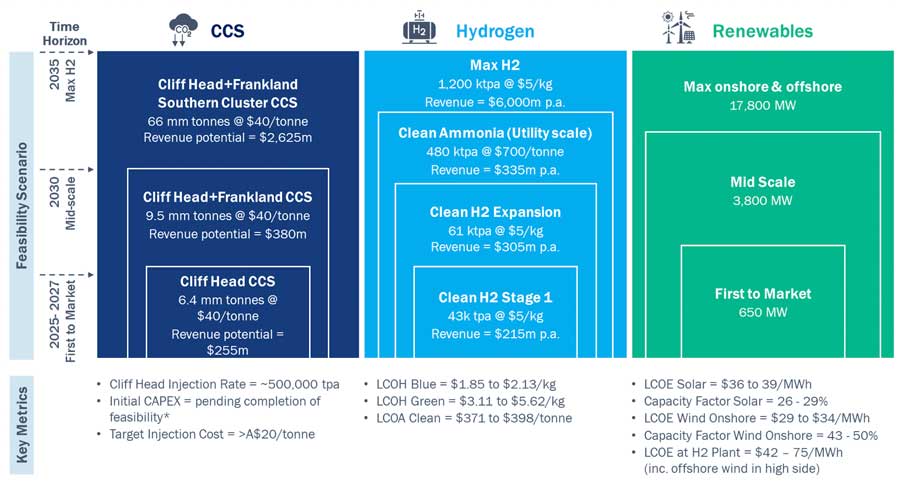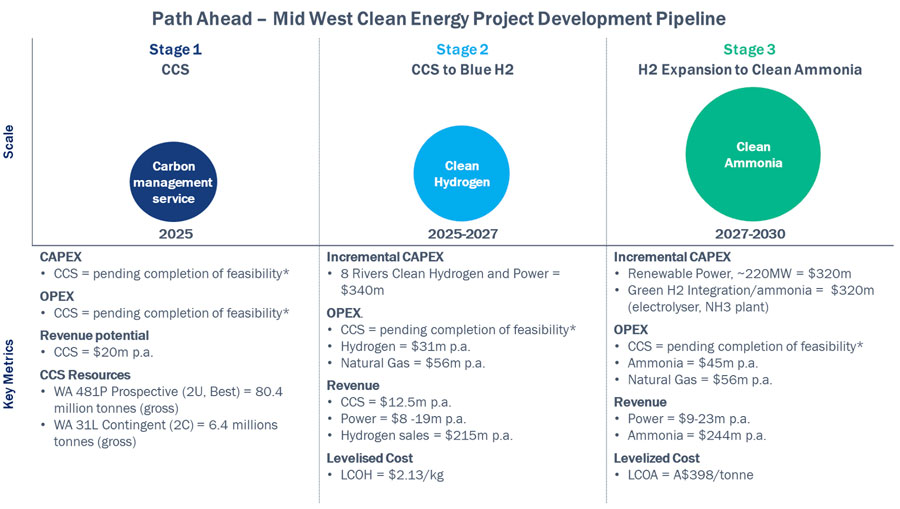Studies back Pilot’s goal to be a globally competitive clean hydrogen and ammonia producer

Pic: Matthias Kulka / The Image Bank via Getty Images
Feasibility studies being undertaken by Pilot Energy in WA’s Mid-West have confirmed the viability of the company’s existing Cliff Head Oil Field infrastructure and operations to be transformed into a globally competitive, integrated clean energy hub.
Investors have been eagerly awaiting the outcomes of the Mid-West Integrated Renewables and Hydrogen Project Feasibility Studies, which show Pilot Energy (ASX:PGY) is in a strong position to build a clean energy project capable of producing hydrogen and renewable energy leveraging its existing operations.
A bonus for Pilot is that the studies have also confirmed the Mid-West region can produce clean ammonia on a globally competitive basis for export into emerging Asian clean energy markets.
“This staged development path is very much in the reach of the company in terms of financial capacity and technical delivery taking advantage of the existing Cliff Head Oil Field infrastructure and operations,” chairman Brad Lingo said.
Lingo said Pilot was also very focused on delivering a “first-to-market” carbon capture and storage (CCS) project in the Mid-West to anchor the further development of a clean hydrogen/ammonia and renewable energy project.
Mid-West has vast CCS, renewables potential
Pilot isn’t just undertaking one feasibility study but four separate detailed studies for each key component of this proposed large-scale clean energy hub.
The feasibility studies for the Mid-West Integrated Renewable Energy Project included the Mid-West Blue Hydrogen and Carbon Capture and Storage Study, the Mid-West Renewable Energy Study, the 8 Rivers Blue Hydrogen Technology Study and the WA 481P CCS Study.
Pilot said each of the completed feasibility studies had confirmed the significant opportunity to develop a large-scale clean hydrogen production project integrating CCS and renewable energy generation to produce hydrogen and electricity for both domestic and export markets.

The CCS study estimated the Cliff Head Oil Field production licence (WA 31L) area had CCS potential of 6.4 million tonnes of CO2 (2C contingent resource) at an injection rate of 500,000 tonnes per annum (tpa).
WA 31L has an upside CO2 storage capacity of about 15.8 million tonnes (3C contingent resource).
The Greater Cliff Head Area extending into WA-481-P has an additional 4.4 million tonnes (2C contingent resource) and a further 56 million tonnes of CO2 storage capacity (prospective resource best estimate) in the area immediately adjacent to Cliff Head.
Following the completion of the WA-31L CCS Study, Pilot and JV partner Triangle Energy (ASX:TEG) plan to seek approval from the National Offshore Petroleum Titles Administrator to have the Cliff Head Oil Field reservoir declared a Greenhouse Gas Storage Formation.
“We are very much focused on engaging with NOPTA and the other relevant regulators to secure the necessary approvals to implement this project,” Lingo said.
Meanwhile, the Mid-West Renewable Energy Study confirmed that the greater Mid-West region contained 18.7 gigawatts of total technical renewables energy resource – onshore and offshore wind and solar – potential in three core development areas.
It pinpointed 15 large-scale potential onshore and offshore development sites.
The study estimates Pilot could deliver green hydrogen to key demand centres across the Mid-West from $3.11 per kilogram on a stand-alone basis utilising only renewable power.
The 8 Rivers Blue Hydrogen Technology Study estimates that Pilot Energy could produce 43,000tpa of globally competitive blue hydrogen at $2.13 per kilogram utilising the industrial scale 8 Rivers clean hydrogen technology (8RH2).
This low-cost blue hydrogen can then be used to produce about 240,000tpa of clean ammonia for less than $400 per tonne and possibly as low as $371 per tonne by increasing production capacity to 480,000tpa.
Pilot said integrating renewables energy into the industrial scale 8RH2 facility could increase ammonia production to at least 345,000tpa.
This has prompted the company to extend the scope of the studies to include the potential development of an integrated ammonia export project capable of initially supplying 240,000-345,000tpa of clean ammonia into international markets.
The Renewables and 8 Rivers studies have both been completed, along with the first stage of the WA 481P CCS Study.
The company is nearing completion of the Blue Hydrogen and Carbon Capture and Storage Study, which is expected to be completed within the next several weeks.
Mapping out the development pathway
With the significant progress being made on the Mid-West feasibility studies, Pilot Energy has been able to plan its development pathway.
The recommended development pathway would see the project brought online in three stages. Stage 1 encompasses the development of a carbon capture and storage operation to provide CCS services to third parties and to support the subsequent production of blue hydrogen and clean gas-fired power.
Stage 2 involves the development of a blue hydrogen generation project utilising the 8RH2 technology and clean power technology to produce ~43,000tpa of blue hydrogen with near zero emissions.
And the final stage covers the integration into the Mid-West Blue Hydrogen Project of about 220 megawatts of renewable power generation from both wind and solar to produce a further 18,000tpa of green hydrogen.

On completion of the three stages, Pilot Energy would be able to produce around 61,000tpa of clean hydrogen and 350,000tpa of clean ammonia to supply into the Asian market.
Pilot aims to have the first stage of the development pathway operational by 2025 to generate positive cash flow and deliver a material impact on carbon emissions in the Mid-West.
This article was developed in collaboration with Pilot Energy, a Stockhead advertiser at the time of publishing.
This article does not constitute financial product advice. You should consider obtaining independent advice before making any financial decisions.

UNLOCK INSIGHTS
Discover the untold stories of emerging ASX stocks.
Daily news and expert analysis, it's free to subscribe.
By proceeding, you confirm you understand that we handle personal information in accordance with our Privacy Policy.








